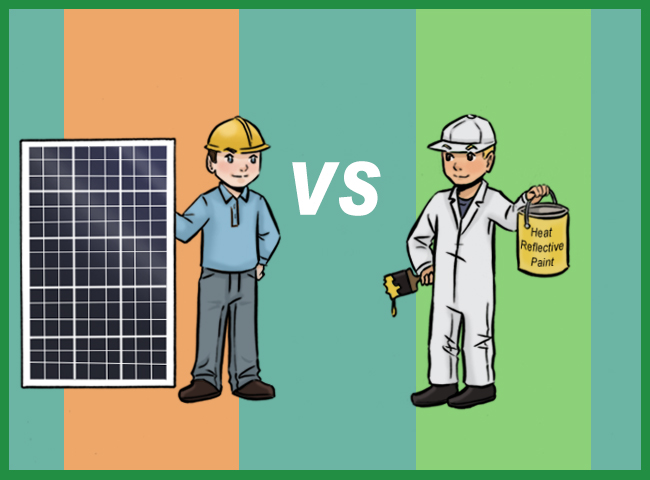
If your house is getting too hot should you invest in heat reflective paint or solar panels?
It can get bloody hot in summer thanks to the sun blazing down on our roofs and making them hot enough to not only fry an egg, but some bacon as well.
This post is about stopping the summer sun heating your roof, turning your home into a metaphorical oven.
There are 2 ways to stop your roof getting so hot:
#1 Make your roof more reflective.
The simplest way to increase the reflectivity of a roof is to make it lighter coloured. A black roof will absorb almost all the sunlight’s energy while a white roof will reflect around two-thirds. There are also specialist heat reflective paints, but their effect is small compared to going from a dark to a light colour.
#2 Cover your roof with solar panels.
Solar panels cool your home in 3 ways:
- They shade the roof beneath them. While the panels may get hot, the air gap underneath prevents most of the heat from the being transferred to your roof.
- Solar panels are dark and so absorb most of the sunlight energy that falls on them, but they turn a portion of that energy into electricity which stops them getting as hot as they otherwise would.
- The solar electricity generated can power air conditioners. While light coloured roofing material or heat reflective paint can reduce the need for air conditioning, it can’t power it, so this is a huge advantage.
I’m going to compare the economics of using heat reflective paint versus installing rooftop solar1.
Rather than keep you in suspense, I’ll tell you right now that when the value of solar air conditioning is included, rooftop solar comes out way ahead. It doesn’t just win by a country mile, it wins by such a long way it must be like a mile on Jupiter.
A Roof By Any Other Name Would Feel As Cool…
If you want to know what to call a roof that’s cooler because it’s lighter coloured, there are plenty of terms to choose from. In fact, there are too many terms. If you want, you can call it a cool roof, a reflective roof, a low solar absorptance roof, or a white roof – even sometimes if it’s not white. But me, what with my knowing so many fancy words and all, use the term high albedo roof.

“When I use a word it means just what I choose it to mean – neither more nor less. And in this case it means albedo.”
Albedo is simply how much light an object reflects. Something with high albedo reflects a lot and something with low albedo reflects very little. The white marble of the pallid bust of Pallas above my chamber door is high albedo, while the black feathered raven perched upon it is low albedo2.
Roofs vary a lot in albedo, mostly based upon their colour. Because I love me a good bit of Colorbond, I’m going to include this link to a page showing how reflective their roofs are. Unfortunately, just to be difficult, they use “solar absorptance” which is the more or less the opposite of albedo. Their roofs include the very dark “Nightsky” which reflects only 4% of sunlight energy falling on it and is very popular among serial killers and other maniacs, while their very bright “Whitehaven” reflects 77% of sunlight energy and I understand it is Pauline Hanson’s favourite.
What A Light Coloured Roof Can Do For You
Compared to a dull old dark coloured roof, a nice reflective, high albedo one can reduce the cost of air conditioning by up to 15% for a single story home. Or at least it can according to the United States government, and when have they ever lied to us?
But a 15% reduction in air conditioning costs isn’t exactly fantastic. Also, a light coloured roof can increase the need for heating in winter because the roof doesn’t get so warm. But in Australia the vast majority of homes will come out ahead by having a light coloured roof.
In warm places, such as Brisbane and Perth, light coloured roofs will save on energy costs overall and as for Darwin – does it ever get cold there? I would expect Hell to freeze over before that place does.
Looking at aerial photos, I can see there are already plenty of light coloured roofs in Queensland and the Northern Territory. But in Perth, while commercial and industrial roofs are bright white, most house roofs are fairly dark. Clearly, the people of Perth are completely nuts.
The Cost Of A Reflective, Light Coloured Roof
If your home is being built or you are replacing your roof, then using light coloured roofing material is essentially free. If you like, you can pay more for heat reflective roofing material that can be extra cool, but for the most part light coloured roofs don’t cost more than dark ones. So unless you live somewhere real cold,or you know you’re not going to use much air conditioning, choosing dark roofing material is not very bright.
But if you have a dark coloured roof and you want to make it lighter, then you have to either pay for a new roof or you can take the less expensive but still pricey option of adding a coat of paint. This could either be regular, light coloured roof paint, or it could be heat reflective paint.
Trust Dulux Paints? Sure Couldn’t!
Dulux used to claim their heat reflective InfraCOOL paint would lower indoor temperatures by 10 degrees and their Weathershield Heat Reflect paint would lower temperatures by 15 degrees. Unfortunately, these claims were completely unsubstantiated and so Dulux was fined $400,000 for bullshitting.
Dulux no longer sells Weathershield Heat Reflect paint and they are much more cautious with what they say about InfraCOOL paint.
Heat Reflective Paints Need To Be Light Coloured
Heat reflective paint will cause more sunlight energy to bounce off than normal paint of the same colour. But the effect is only moderate compared to painting a dark roof with non-heat reflective light coloured paint. For example, if painting a black roof with normal white roof paint would cut air conditioner energy use by 10% then using heat reflective white paint would only cut it by roughly 12%. Covering it with identically coloured heat reflective black paint would only reduce air conditioner energy use by roughly 3%.
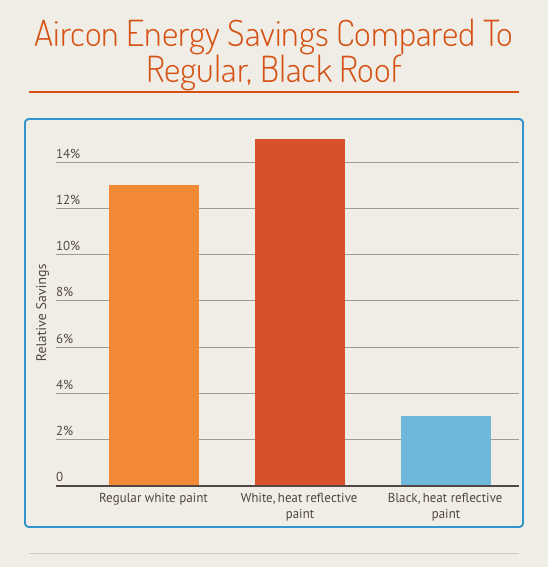
Colour of the roof is more important than the type of paint used.
Heat Reflective Paint Is Not Cheap
Neither normal roof paint or heat reflective roof paint is cheap. I have an estimate for the cost of coating a commercial galvanized iron roof with Dulux heat reflective paint. It comes to around $40,000 for a 3,000 square meter roof. That’s about $13 per square meter. Coating a normal house roof is likely to have an even higher cost per square meter.
The average Australia home has around 160 square meters of roof space. If it is assumed that heat reflective paint costs $15 per square meter then the cost of covering the roof will be $2,400.
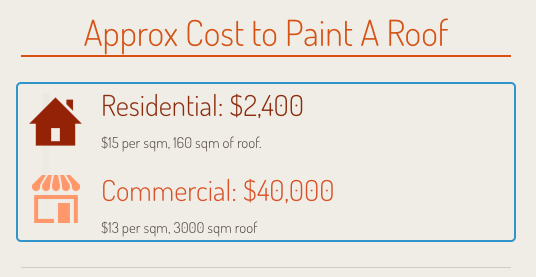
Paint is expensive.
Financial Returns From Heat Reflective Paint Are Low
In a hot location such as Townsville a household of 3 people will often use around 2,000 kilowatt-hours a year for air conditioning. At their current cost of electricity of 27.1 cents a kilowatt-hour this comes to around $540 a year. So if a dark roof is covered with light coloured heat reflective paint and cuts air conditioning energy use by 15% it will save around $80 a year. If it is assumed that painting the roof costs $2,400 and it lasts forever that will give a return of around 3.3%. For households that use twice as much electricity for air conditioning, the return would be a more respectable 6.6%. But note it is possible to be charged a lot more than $2,400.
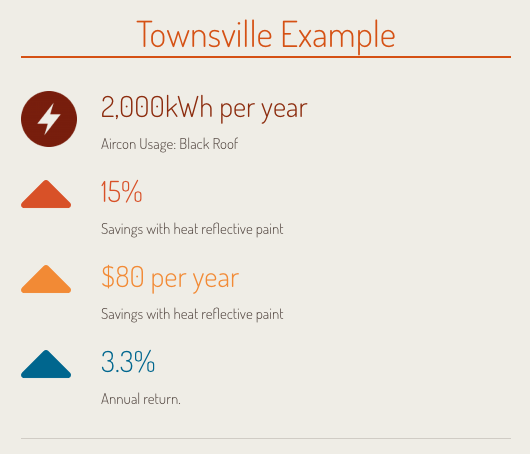
The financial return from heat reflective paint is modest.
Most roofs in Townsville are already fairly light coloured, but there are still quite a few dark roofs. It’s not nearly as bad as Perth where they apparently love heatstroke, but it is bad enough to make me think they’ve gone a bit troppo up there.
As most Australian homes use far less air conditioning than those in Townsville and because they will have to pay slightly more for heating costs in winter, the average return from painting a dark roof with light coloured heat reflective paint is likely to be under 2%. This is worse than a term deposit and so is not economically worthwhile.
The Cooling Benefits Of Rooftop Solar
Because solar panels shade the roof beneath them and only transfer a limited amount of heat to the roof, they should result in less solar energy being transferred to the roof than any type of roofing material, whether it is specially designed to reflect heat or not. It won’t be 100% effective, but it is reasonable to assume it would prevent at least 90% of the energy in sunlight being transferred to the roof as heat.
But solar panels only cover a limited amount of roof space. A system with 5 kilowatts of solar panels will only cover around 30 square meters of roof or about 19% of a 160 square meter roof. It is likely to be located on a north facing section of roof which is the part that receives the most sunlight energy, but even so, solar panels that cover 19% of a dark roof may may only reduce air conditioner use by one quarter as much as covering the roof with white heat reflective paint.
Just like light coloured roofs, solar panels can slightly increase the need for heating in winter, but this will normally be far outweighed by the benefits of cooling.
So even on a dark roof in a hot location such as Townsville, a 5 kilowatt solar system may only save around $20 a year in air conditioning costs. While this is better than nothing, the amount is so small it can more or less be ignored.
What does make rooftop solar a far superior investment to heat reflective paint is the fact it generates electricity while paint just sits there looking pretty.
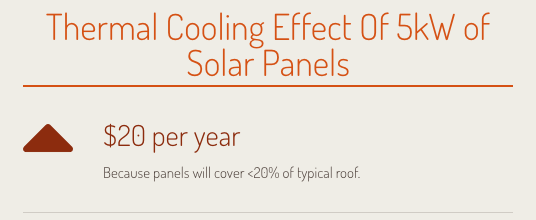
Almost insignificant.
The Economic Return From Rooftop Solar
PVwatts says 5 kilowatts of north facing solar panels in Townsville can generate over 7,900 kilowatt-hours a year. If a family self consumed half that electricity and sent the rest into the grid, then at the current grid electricity price of 27.1 cents per kilowatt-hour and feed-in tariff of 7.45 cents, it would reduce their electricity bills by around $1,360 a year. If the system cost $7,000 its payback time would be around 5 years and 2 months. If the system works perfectly for 15 years and then is scrapped the return will be about 13%.
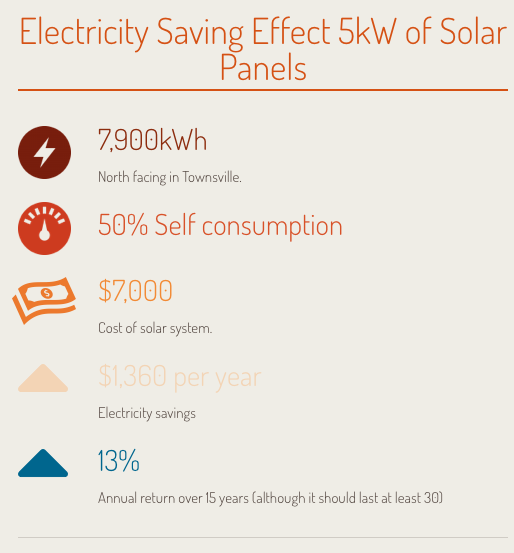
A quality rooftop solar system should not need to be scrapped after just 15 years, but even with my conservative assumptions, rooftop solar is one of the best investments that roof owning Australians can make.
Solar Air Conditioning Beats Heat Reflective Paint By Miles
The time to decide on a light coloured roof is before it is built or replaced.
While painting a dark roof with light coloured heat reflective paint can be worthwhile for buildings with very high air conditioning costs, your money will almost always be better spent on solar panels.
Even where air conditioning costs are high, rooftop solar still gives a better return, as it will cool the roof and generate electricity to power air conditioning and anything else that uses electricity during the day.
Footnotes
- I’m doing this because a reader emailed me to ask if I thought he should buy heat reflective paint instead of solar panels. And I’m buggered if I’m going to spend a day researching his question and not get a blog post out of it. ↩
- And the albedo of the dark shadow from which my soul shall be lifted nevermore, is even lower. ↩

 RSS - Posts
RSS - Posts



Great article. Thank you for posting.
You didn’t mention the effects of insulation and any benefits?
I didn’t go into insulation on account of article length. But it definitely helps. Maybe when winter starts to bite and I am shivering in my shack while Finn is nice and warm in his well insulated eco house, I will write an article about its benefits. Of course, just how cost effective it is will depend on circumstances.
Insulation dramatically decreases your cooling requirements, not just your heating requirements. Always amazed me that Australian houses didn’t have insulation, double pane windows, and air tight seals, but they would install 2-3 air conditioners in a small home. Insulation works both ways and is a FAR cheaper option.
Hello…… Hell Actually exists. It is a city in the lower part of the State of Michigan U.S.A. Yes, It Does freeze over. Christmas also exists . It’s in the Upper peninsula . Been there many times.
dcadwell
I saw on the news tracker during the hurricane town called barbecue last year in #2018
Yes, a high albedo (e.g. white) roof will be warmed less (than a black roof) by sunlight in winter, but at night and in less than brilliant sunshine, the white roof should (I reckon) provide a warmer interior, since black radiates heat so much better than white. I.e. When the heat flow is outward, as it almost invariably is in our southern winters, then the higher radiative thermal resistance of the white roof will reduce heat loss relative to the dark roof, which is closer to a “black body” radiator, the ideal for dumping heat radiatively.
Maybe the best is to buy cheaper low-efficiency solar panels, so that more of the roof is covered? 😉 (Or just fill the north roof with good panels, as I’m going off-grid – away from bureaucratic limits.)
If the underside of the panels is also white (or bright metal), then despite their increased summer temperature, their rearward radiation will be much less than if dark, and the high albedo will reflect much of what does radiate, receiving less than if it were dark.
people are crazy to not to cover their roofs while the solar rebates are still on
I use a soaker hose on our roof. The power for the pump comes from the solar panels so doesn’t cost anything … but this is offset by the equivalent power not going back into the grid.
As for the a.c., most of the time it is used on the dehydrate setting in summertime which gives a nice cooling effect without the cold blast of the cold setting, which if it is set to that, is set at 24°C. At this temp. the outside temp. is into the 30’s … We live on the Atherton Tablelands, FNQ, which has a relatively cooler climate than Cairns, 85 kms away.
As a side issue, our ERGON account has been reduced from avg.$500 per 100 days, to avg.$78 per 100 days. The solar setup cost was covered within 5 years
Solar World claim there Bisun panels which converts light from both sides of the panel will produce up to 13.4% more power from a reflective/white roof than a dark/non reflective roof.
Has anyone tested or seen this occur?
A bifacial panel will need to be raised off the surface of the roof to get the benefit of light being reflected off the surface below it. On a bright white flat roof, raised, angled bisun panels should be able to generate extra power compared to monofacial panels from reflected light. But when laid flat on a roof, as most panels are, I would expect them to perform about the same as an otherwise equal standard panel.
You think Perth folks are mad, have a look at new housing in Sydney.
There seems to be a notion that black roofs are cool looking, similar to black cars which also abound here.
Nearly all new houses in western Sydney where it is hottest are black.
Same in Adelaide…
Great article Ronald! Since I and many of my clients track the sun the roof is out.
A modern mini-split can easily cool the home and I live in an area that can cook bacon and a meter of beef easily.
I use to go thru all the energy saving and building tricks for really low energy and heating for offgrid. The mini-split has changed all of that. We use the concept of a small unit (12,000 btu) cooling (in a central location) the whole home. By tracking we have summer power from 6am to 7pm to run the split. Some homes may need a second split and it is also a good spare.
There should be some news in May on the Schneider Electric Solar and LG Resu10. Hi to Tonto!
Nothing new here. Remember when Landrover 4wd’s were offered with an optional “tropical roof” which consisted of a raised external roof section which allowed airflow and heat separation to keep the inside of the vehicle cooler Maybe we should pressure car manufacturers to offer a “solar option” of similar design. We could plug the car panels into our home solar as an augmentation addition.
Don above; those new houses dont have eaves as well.
I have though of mirror plastic on the roof, on a flattish section anyway. Guaranteed for 10 years
Aircraft? Pools reflect already.
Yes I have been thinking along those lines for my latest 6.34Kw of panels as they are at a 38 degree tilt so would benefit even more from extra reflected light.
Ronald, do you know of any research data on this? It could be a new blog?
I don’t have any figures for mirror plastic but I suspect it would have a lower albedo and reflect less sunlight energy than a nice white bit of colorbond roofing material.
Cool, then I think I will just paint a patch of white ‘solarguard’ in front of each panel- much the easiest and long lasting.
Thank you!
Okay, let me think about this…
You have a flat roof with racked up panels at 38 degrees. Assuming your roof is dark and you paint it with high albedo paint, you will get a real, but very small increase in the amount of indirect light hitting your panels. Some of the light reflected off the new paint will hit the panels, but not a lot as they are mostly angled away from it. Off the top of my head I’d say your panels might generate 1% or less additional energy, so that won’t pay for the cost of the paint job, but it would still make your roof cooler in summer.
Great article Ronald. Thanks. Another scenario you haven’t covered is when a homeowner has decided to get their roof painted anyway for aesthetic reasons. Then it’s a complete no-brainer for them to use a light coloured paint before putting their solar panels up.
If you have a pitched roof then removing the heat build up from the roof cavity will dramatically reduce the heat that enters your living space, below the roof cavity. A high volume fan 30,000 – 50,000 m3 per hour will draw air through your house and expel the hot air in the roof cavity. I have used a “whole house fan” in two premises that I have renovated. If you draw your air through the house from a cooler side then the breeze gives a cooling effect to the occupants. They used to cost about 1.5c per hour to run.
Ps. I do not own shares, have a direct or indirect association with any company that sells these systems.
Well said Duncan: a modern version of opening a window!
To those involved in the design/construction of ‘alternative’ houses for years it was obvious the old-fashioned insertion of openable windows/vents at the end of the gables was a no-brainer, generating cross-flows of air, since rising heat had nowhere else to go.
In houses on hillsides with under-floor cavities another interesting innovation was to install (as many as necessary) vents (like those in central-heating installations in the floor AND the ceiling.
The idea first surfaced whilst trying to figure out how to make power-guzzling fridges more efficient, in the days when solar-panels cost about 20 times today’s prices. The favoured solution was to put a grate in the floor and in the ceiling (or even the roof if one had no ceiling) to generate a draught over the condenser fridges used to have attached on the back. Purists
even fitted a range-hood sort of set-up over the fridge.
Even on the hottest days the temperature disparity was enough to create a draught, which in turn created that ‘cooling breeze’ of which you speak. Since heat always rises a high-volume fan wasn’t needed, though in larger muddies we’d use a truck tyre as formwork around which to create the gable-end vent.
Incidentally, a little bit of lateral thinking dictated that the ‘gable-end’ vents could also be incorporated ~ equally effectively in a house with no ceiling:- simply install the vent at the highest point of the skillion ~ and it doesn’t necessarily have to be round ~ but in such a (non-insulation) configuration an insulated and sealable flap/shutter is called for over the winter.
Afterthought:- People who live in ~ or even allow in their neighbourhood ~ those eaves-free monstrosities need to have something rude done to them with a pineapple……on both engineering and aesthetic grounds.
The engineering aspects of pineapple insertion are likely to be far easier to accommodate than are improvements to the aesthetics of such a project. Nevertheless I concur that something needs to be done to gain their attention.
One big miss of the article to consider. The fastest growing technology here in the US is elastomeric silicone roof coating. While your energy comparisons of solar versus roof ‘paint’ may have some validity, a big plus for using an elastomeric silicone roof coating is because it provides both energy savings AND Waterproofing. For flat roofs there is no better way to repair leaky roofs than to apply a monolithic coating of an elastomeric silicone roof coating. Typically warehouses and large flat roofs have cheap TPO rolled roofing installed. After several years these roofs develop cracks and also begin to leak at the seams. There are now outstanding silicone roof coating products that offer the best of reflectivity while passing the ASTM 7281 test for waterproofing. Solar panels typically are installed by penetrating the roof and this results in potential leaks. Silicone can take care of that too!
You assume that solar panels reduce the heat reaching the roof by 90%. Where in the world are you taking that number from?
It’s a pretty big assumption to make.
Well, I said, “…it would be reasonable to assume it would prevent at least 90% of the energy in sunlight being transferred to the roof as heat.” Let’s say there is 1,000 watts of sunlight energy hitting each square meter of solar panel. Very roughly, if 20% is reflected and 20% generates current, that leaves 600 watts absorbed as heat. This heat can be lost through conduction to the air. I think we can assume under normal circumstances heat transferred to air on the upper side of the panel won’t be transferred to the roof and, while it will depend on how much wind there is, I don’t think there would be much heat transference from air on the underside of the panel to the roof. That leaves conduction from the clamps holding the panels to the rails to the roof — again probably not a lot. That leaves direct radiation with radiation from the upper surface clearly not transferring heat to the roof and a portion of what remains reflecting off the roof, although that will depend on what it is made of.
So while it was an assumption on my part, I don’t think it was an unreasonable one. But it would be nice to have hard numbers on this.
Not only does the heat radiated from the upper panel surface not impinge on the roof, but it could readily be made 30 times higher than that radiated down. The PV panels I have to hand have a bright white rear, but the emissivity of white paint is similar to uncoated glass, at 0.9. (Out of 1.0) However, an aluminium foil has an emissivity of 0.03 – job done.
Now, who sells PV panels with a bright metallic rear face? (N.B. Aluminium must not be anodised in this application, as the emissivity would then shoot back up to 0.9)
If the PV array is say 15 cm up from the roof, as needed for leaf removal, and tilted for improved solar orientation, then convection will carry little or no heat to the roof. Conduction through the thin wafer of the panel to the edges, then down through the four mounts is a long thin path of significant thermal resistance, resulting in minimal heat flow. (Glass is a poor thermal conductor, and the silicon is even thinner.)
A reasonable first-order approximation is 5% to the roof, 95% out through radiation and convection, based on the numbers.
Thank you.
In case of heat reflecting paint whether it has any impact on water quality, particularly when rainwater harvesting is associated.
Hi K Shashidharan
Having a little while back painted an old Colourbond roof also used for drinking water collection, I do agree you do have to be careful about what product you use.
Dulux have a product named Roof&Trim that they say is suitable for water collection following rinsing to remove surfactants (unless this is also BS…) and they say Weathershield is not suitable.
With respect, I do wonder if Ronald is suffering a little from “confirmation bias” (concerning a little of his analysis). Certainly the albedo of a light coloured roof will reflect up to 77% of the light falling on it. So absorbes about 23%. But fill this roof with solar panels, and these probably absorb nearly 100% of the energy falling on them, but let’s say 96% of this energy (to be equivalent to NightSky). Commercial panels convert ~ 11-15% to electricity so subtract say 15% of this (to be optomistic) and we get 81.6% of the incident energy is absorbed as heat to be dissipated as heat – about 3 and a half times as much as a white roof.
While I do agree that less of this is absorbed into the roof space, the issue of “thermal islands” still applies – the dissipated heat will STILL heat the area around, so making the environment locally hotter – as is noticed in suburbs with predominantly dark roofing. So the A/C benefits may be less than you’d think (have to include extra heat coming in through windows and walls).
In fact I could argue (but wouldn’t, as I don’t have the data, nor do I think the scale of solar is that great in terms of surface area proportion just yet), that solar panels are contributing in their small way, to global warming and climate change! While I’m at it, I should mention that Wind Turbines draw their energy from the wind, by slowing down that wind significantly – so again I coud argue that wind turbines are changing wind speeds snd patterns therefore also impacting climate change. My feeling, although I do not have the data to support this conjecture, is that the penetration of Wind power is presently too small of scale for this effect to be significant at this time.
But, we should keep open minds on all these matters…! I’d hate to think we might get 20 years down the track, only to find we have buggered-up the climate by the very actions we have taken to curtail the problem – as we have done previously with bio-solutions to other problems.
As this article states, it is not exactly an in depth look at all the parameters such as insulation etc. You may want to paint your roof white, under a few conditions especially if it needs to be done as a matter of maintenance. I live on the NSW coast in Nowra. My house was 50 years old and before I took the plunge and got solar panels, the tile roof needed repointing and painting. My wife and I decided not to replace the tiles with colourbond and she choose to have it painted Arctic White and I am glad I listened to her. The roof stays cool all year round and is never hotter than the ambient air tempertaure, the roof cavity is never a stifling hot box in summer. I keep two tiles on hand to put out for when guests come and demonstrate to anyone who will put up with me, that the old mission brown tile is too hot to touch and the white tile is actually cold, IT ABSORBS NO HEAT FROM THE SUNLIGHT only the ambient heat of the surrounds. I then get them to touch the colour bond carport and despite being white, the metal surface is too hot to touch midday in summer. This phenomen of concrete tile versus metal is something I wasnt expecting or fully understand. I do not need to use airconditioning as the house is insulated enough that we can avoid it except for the hotest few days of the year. As for the lack of heat from the roof in winter? Now if the heat from the dark roof can warm your house in winter, it can also disipate it quickly when the sun goes down. Also if it is warm in winter then it must be an absolute oven in summer. I know what an uninsulated house in Adelaide was like in winter sun with warmish days in winter and freezing cold at night. So, if you use your aircon a lot less in summer due to a white roof, that will save you money and therefore worth considering in conjunction with insulation.
I have also lived in Canada where temperature swings from plus 40 to minus 40 demonstrated the two way value of insulation, but dont get me started on that one!